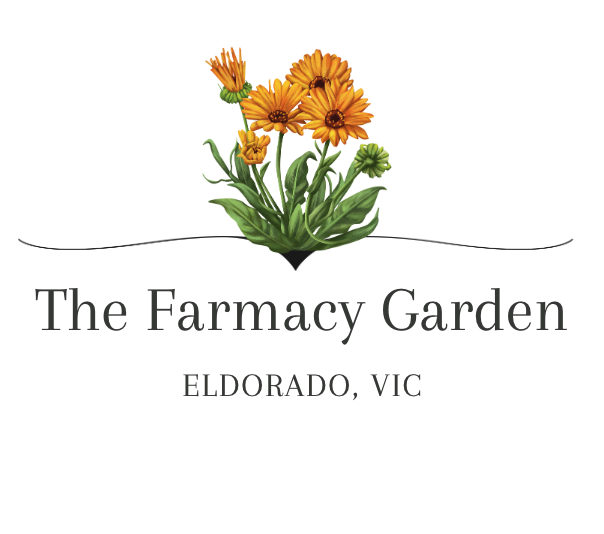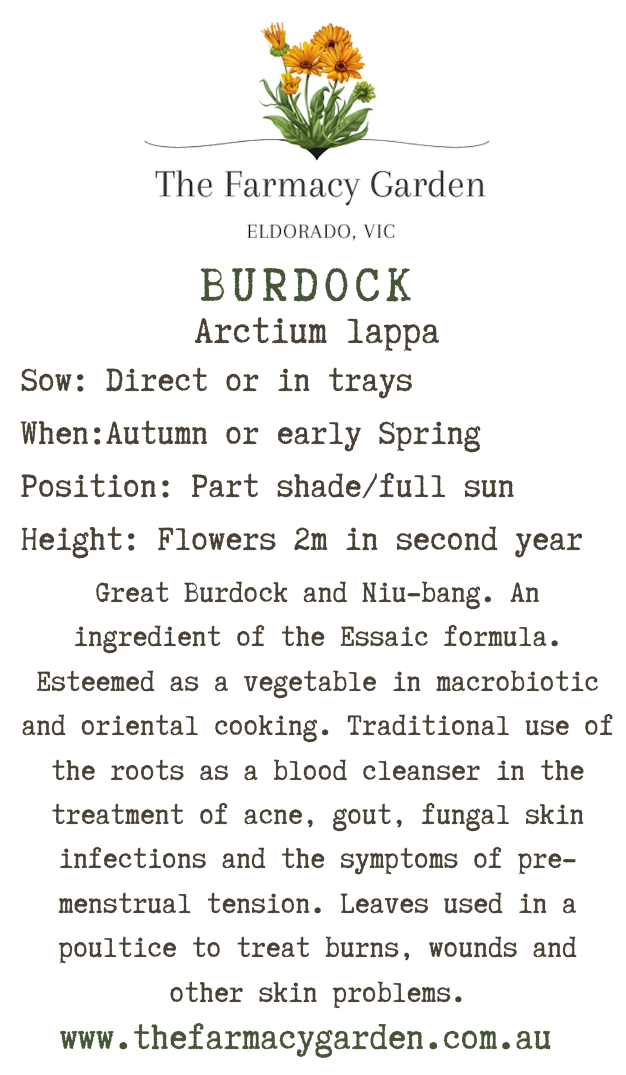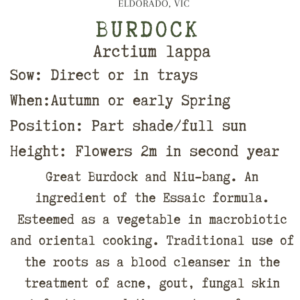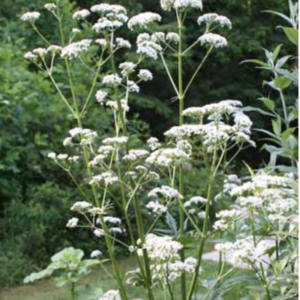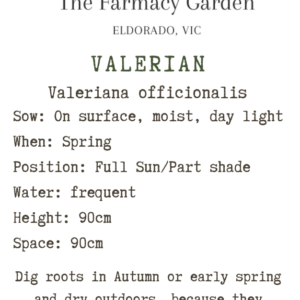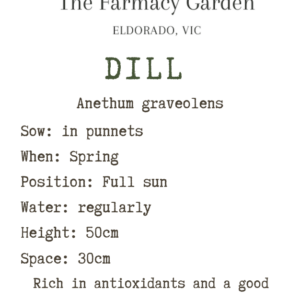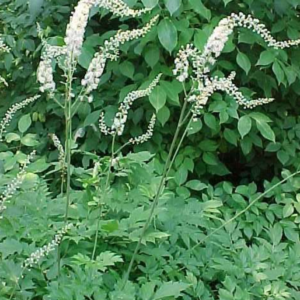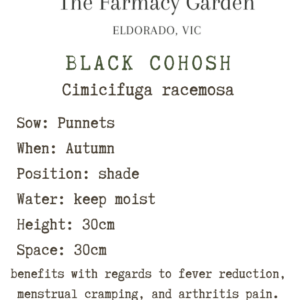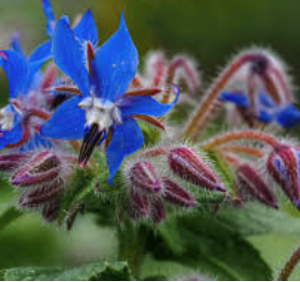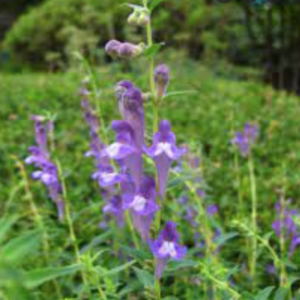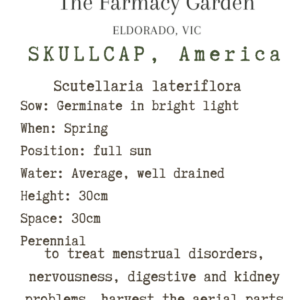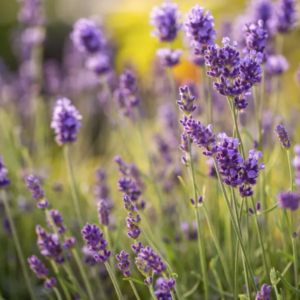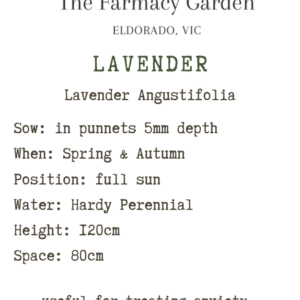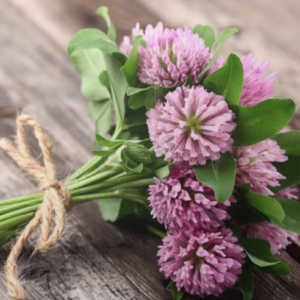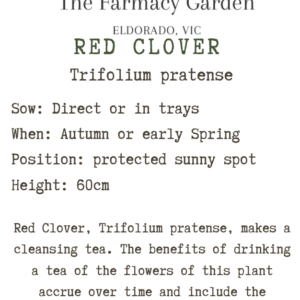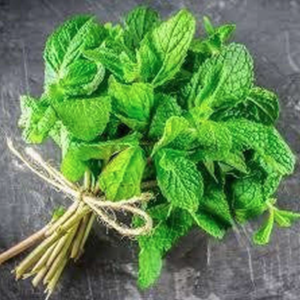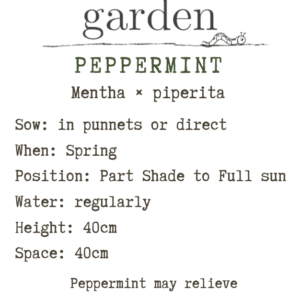Burdock Seed, Arrctium lappa
$4.50
Burdock is grown as an ornamental, culinary and medicinal herb. The young leaves are used in salads or cooked, and the roots and flower spikes are used in a range of cuisines as pickles or steamed, baked or boiled. Some cultures collect the seeds, sprout them and eat them like bean sprouts.
Burdock is grown as an ornamental, culinary and medicinal herb. The young leaves are used in salads or cooked, and the roots and flower spikes are used in a range of cuisines as pickles or steamed, baked or boiled. Some cultures collect the seeds, sprout them and eat them like bean sprouts.
GROW:
Optional: Soaking seeds prior to planting may improve the speed and success of germination. Soaking seeds in water can help to soften hard seed coats, which can break dormancy and spur the seeds to germinate.
Burdock seeds grow best when they are sown directly into the garden.
- Sow seeds directly in the garden 15mm deep and 15cm apart, with rows 60cm apart.
- Keep soil moist but never wet or dry.
- Seeds should germinate in around 7-14 days at a soil temperature of 20-25°C.
- Young seedlings will need protection from pests, pets and weather until they are established.
HARVEST: Burdock leaves should be harvest while they are young and tender. In its second year of growth it will produce purple flowers. Burdock root and leaves can be harvested as early as 8 to 12 weeks after sowing the seeds in the spring. If burdock becomes too large, it will quickly become difficult to harvest, which is why it is important to harvest the plant while its young. To harvest the plant, use a shovel or garden fork. Dig a hole next tot he root so you can leverage the roots into that space.
Burdock is a biennial plant, meaning it flowers in the summer of its second year. The first year, burdock directs its energy and nutrients into growing its basal leaves and establishing roots. The second year, burdock directs its energy and nutrients into producing seeds, so will grow to many feet tall, producing more leaves, flowers, and ultimately, seeds.
Late summer or autumn of the first year is the best time to harvest burdock root as the plant has been putting its energy and nutrients into the root for months. Alternatively, the root could be harvested in the spring during the second year.
Harvesting burdock root is not a light commitment! Its long taproot can grow to several feet in length and does snap easily, so the key is to dig around the root gently, loosening and removing the soil with depth. Because burdock root harvest does require excavating a large hole, disrupting soil structure and microorganisms, it’s important to only harvest the number of roots that you truly need, only take a small portion of plants in an area, and take care to fill in the hole and restore the area as much as possible after harvest.
USE: Burdock root can be eaten raw or cooked, and it is an excellent source of folate, vitamin C and pantothenic acid.
Burdock root is cooling and grounding, with a sweet, starchy taste that pegs it as nourishing and building. This is a root chakra plant that I turn to for centering, grounding, and connecting to the earth, enjoying it regularly as a decoction. You’ll find that the rehydrated pieces of burdock root in the decoction are juicy and refreshing, and worth nibbling from the bottom of your cup.
Burdock root is a great ally for the digestive system. It is rich in inulin, a pre-biotic that feeds our gut bacteria and supports a healthy gut microbiome. Inulin also helps our bodies regulate blood sugar levels. If you make a tincture of burdock, you will see the inulin settle to the bottom as a white precipitate. Burdock is also a mild bitter, stimulating digestive secretions to help improve appetite, digestion, and absorption of fats.
As an alterative and lymphatic herb, burdock root nourishes and strengthens the body’s filtration systems (kidneys, liver, and skin) to aid in cleansing the blood and supports the flow of the lymph, supporting the movement of wastes out of the body. This can support clearing of eruptive skin conditions such as acne, psoriasis, and eczema.
Burdock can also be used externally. Leaves can be blanched and used as antimicrobial and anti-inflammatory poultices for burns or skin sores.
Related products
Flower Seeds
Flower Seeds
Flower Seeds
Flower Seeds
Medicinal Herb Seeds
